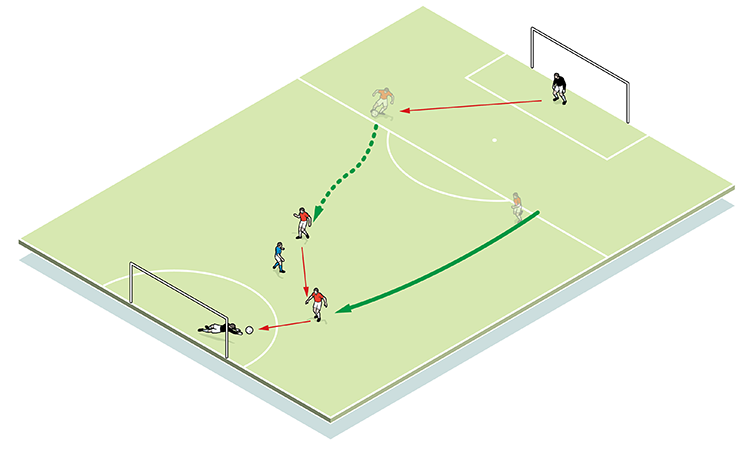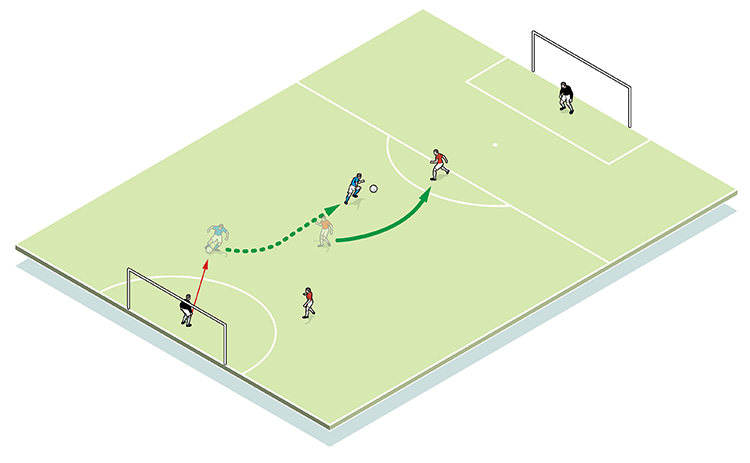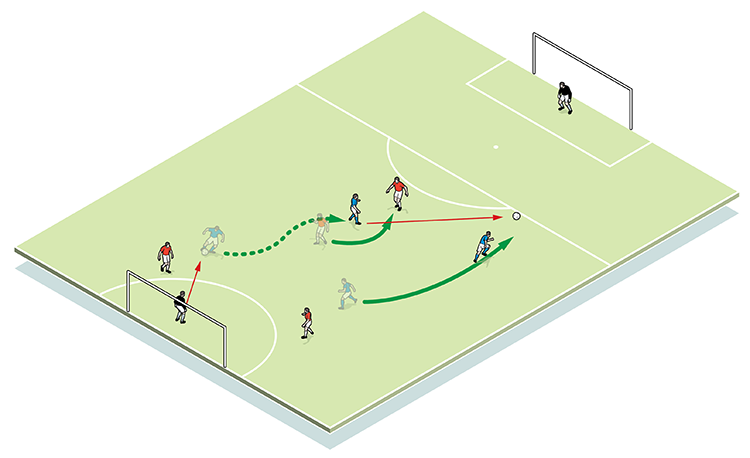




OUR BEST EVER OFFER - SAVE £100/$100
JOIN THE WORLD'S LEADING PROFESSIONAL DEVELOPMENT PROGRAMME
- 12 months membership of Elite Soccer
- Print copy of Elite Player & Coach Development
- Print copy of The Training Ground
You are viewing 1 of your 1 free articles
Perfecting counter-attacking
Counter-attacking quickly and efficiently is often the best way to defeat good defences, so it’s important to practise this because defences are now so well organised, even at youth level.
| Area | 60x44 yards |
| Equipment | Balls, cones, goals |
| No. of Players | Up to a full squad |
| Session Time | 20mins per practice |
This session looks at developing counter-attacking skill for players of all ages. It’s important to practise this in the modern game because defences are now so well organised, even at youth level. That means counter-attacking quickly and efficiently is often the best way to defeat good defences.
The session looks at 2v1 and 3v2 counter-attack situations; it maintains a high tempo throughout and gets players thinking about support, communication and unity between team mates in perfecting the skill.
We’ll run this with players of all ages because good counter-attacking can be done well by anyone.
What do I get the players to do?
We set up as shown, but can use multiple practice areas.
2v1s into 1v1s
This practice is 2v1 on ‘the way out’, and 1v1 on ‘the way back’.
Setting up as shown in a 60x44-yard area, it begins with the keeper feeding the ball out to either attacker.
He attacks the lone defender, looking to beat him and score in the goal (1a). If successful, the scorer remains at the far end and defends next time. The player who previously defended now receives a ball off the keeper and attacks his remaining opponent (the recovering attacker) in a 1v1 (1b). Both players rest after the attack.
1a

1b

If, on the way out, the defender intercepts or tackles then he immediately attacks the other end, and the attacker who made the mistake must defend, leaving the other attacker to defend on the next rotation.
3v2s into 2v1s
This practice is 3v2 on the way out, and 2v1 on the way back.
The keeper can feed to either of the three attackers who go up against two defenders looking to score. The receiving attacker must attack centrally while the other two run down the sides (2a). The central attacker always becomes the defender on the way back in a 1v2 (2b), while the other two remain to defend next time.
2a

2b

If the defenders intercept, the keeper makes a save or a shot misses, those two players attack the other end and the central attacker must defend.
When the ball goes dead, rather than start with the keeper, coaches can serve a new ball in immediately. This ensures the tempo remains high.
What are the key things to look out for technically/tactically?
We want to see running with the ball at speed with plenty of support from behind the ball and down the sides. Decision-making must be good, with players recognising when to pass, when to dribble and when to shoot. And recognition of the ball changing hands is important too, so we want each player to be able to adjust his mindset quickly from defence to attack, or vice versa
Related Files
Editor's Picks
Attacking transitions
Deep runs in the final third
Using the goalkeeper in build-up play
Intensive boxes drill with goals
Penetrating the final third
Creating and finishing
My philosophy
Pressing initiation
Compact team movement
Coaches' Testimonials

Alan Pardew

Arsène Wenger

Brendan Rodgers

Carlos Carvalhal

José Mourinho

Jürgen Klopp

Pep Guardiola

Roy Hodgson

Sir Alex Ferguson

Steven Gerrard
Related
Pre-season fitness plan
Play around to play through
Free-kick routines
Coaches' Testimonials

Gerald Kearney, Downtown Las Vegas Soccer Club

Paul Butler, Florida, USA

Rick Shields, Springboro, USA

Tony Green, Pierrefonds Titans, Quebec, Canada
Join the world's leading coaches and managers and discover for yourself one of the best kept secrets in coaching. No other training tool on the planet is written or read by the calibre of names you’ll find in Elite Soccer.
In a recent survey 92% of subscribers said Elite Soccer makes them more confident, 89% said it makes them a more effective coach and 91% said it makes them more inspired.
Get Monthly Inspiration
All the latest techniques and approaches
Since 2010 Elite Soccer has given subscribers exclusive insight into the training ground practices of the world’s best coaches. Published in partnership with the League Managers Association we have unparalleled access to the leading lights in the English leagues, as well as a host of international managers.
Elite Soccer exclusively features sessions written by the coaches themselves. There are no observed sessions and no sessions “in the style of”, just first-hand advice delivered direct to you from the coach.







